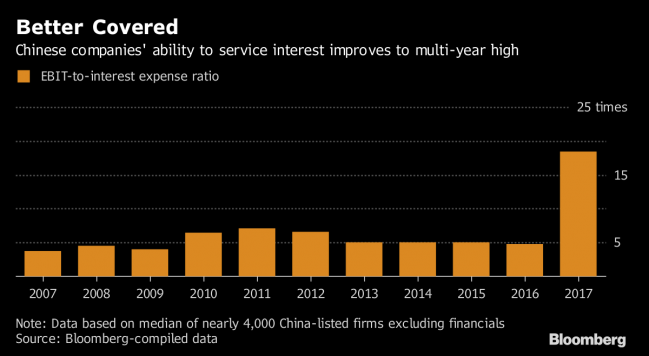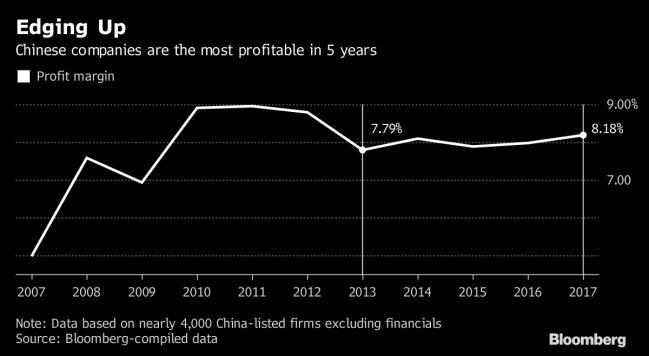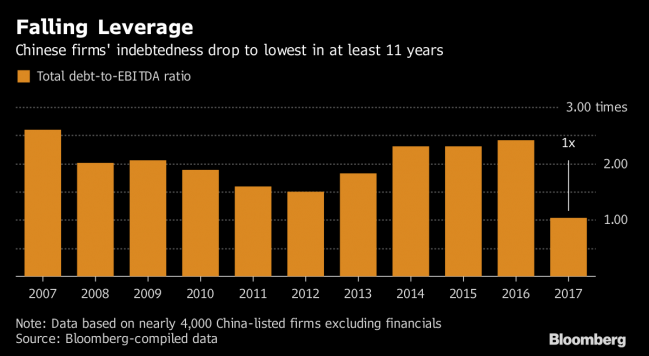(Bloomberg) -- Everyone from President Xi Jinping on down in China -- and plenty of observers outside it -- have warned about the need to rein in leverage in the world’s second-largest economy. What’s gone little recognized is that a large group of its companies has already done just that.
Looking at their capacity to make interest payments along with their debt relative to earnings, listed non-financial enterprises in China on average are in the best shape in more than a decade, according to data compiled by Bloomberg. The improvement has been propelled by supply cuts, rebounding prices and a boom in global trade that have boosted profit growth.
The strengthening position of China’s companies puts them in better shape to cope with the increase in bond yields being driven by regulators’ efforts to rein in shadow banking. That offers scope to keep up the campaign and let weaker players default without sparking broader contagion. While accounting transparency issues remain, it could also encourage investors to look again at a bond market with higher returns than other major economies.
"Profitability conditions have improved a lot, not only for the state-owned companies but also the small and mid-cap companies," said Margaret Yang, an analyst at CMC Markets Singapore Pte. "This will give policy makers more room to push through the deleveraging campaign and keep monetary policy neutral," she said.
As top officials gather this month for their annual Economic Work Conference to set targets for 2018, they can reflect on the fruits of moves to shut down outdated factories and curb the construction of new capacity: even coal miners and other energy companies are seeing higher profits.
Total debt for almost 4,000 non-financial firms listed on the mainland is now on average about the same size as earnings, down from 2.4 times a year earlier, according to data compiled by Bloomberg based on the latest filings. Their operating profits can now cover over 18 times interest expense, a significant improvement from just 5 times in 2016.
Chinese factories are probably now using their capacity at a level that covers their fixed costs, according to the assessment of Mark Tinker, head of AXA Framlington Asia in Hong Kong, who’s been watching markets for about a quarter century. That metric means further increases in sales should trigger even faster profit gains. It also gives him comfort to stick with Chinese stocks after the Shanghai Composite Index trailed almost all of its Asian peers the past year.
The outlook for earnings growth in China spurred Nomura Holdings Inc. to predict double-digit returns for Chinese stocks. The securities company’s strategists see a 16 percent jump in the CSI 300 index by the end of 2018.
Among the numbers cheering investors like Tinker:
- The average profit margin for listed non-financial companies has risen to 8.2 percent, the highest in five years
- Industrial profits rose 25 percent in October from a year before, helped by improved pricing power
- Coal miners and other energy companies saw their profit margin jump to 4.4 percent from 2.3 percent a year earlier. They have also cut their debt leverage to just 2 times from 5 times, according to data compiled by Bloomberg
As People’s Bank of China Governor Zhou Xiaochuan suggested when he warned in October about the danger of a "Minsky Moment" debt-induced crash, it’s not necessarily private companies that are the biggest worry. Corporate debt measures incorporate some obligations of entities set up by local authorities, a big source of the credit boom unleashed during the global financial crisis.
Local authorities and their related units aren’t included in the debt metrics compiled by Bloomberg. Read more here about how tougher times may be looming for weaker players.
Even with the improvement in corporate fundamentals, some asset managers say it’s best to keep to the safer parts of China’s bond market. Cary Yeung, Hong Kong-based head of greater China debt at Pictet Asset Management, prefers state-owned enterprises with strategic importance to China.
The latest look at companies’ pricing power comes Saturday, with the release of the producer price index. After years of deflation from 2012 to 2016, the gauge has been averaging gains of 6.5 percent so far this year.
“Good financial health of China’s corporations right now gives Chinese regulators a good window to execute supply-side capacity cuts and deleveraging,” said Xia Le, chief Asia economist at Banco Bilbao Vizcaya Argentaria SA in Hong Kong. “The Chinese government is taking the debt issue very seriously.”
(Updates with Nomura outlook in paragraph under ’edging up’ graph.)




